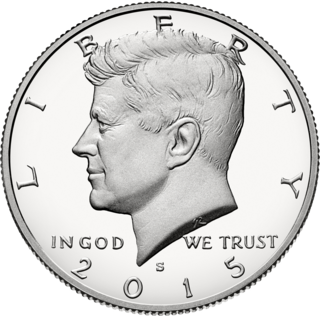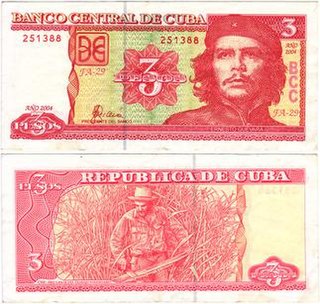Related Research Articles

ISO 4217 is a standard published by International Organization for Standardization (ISO) that defines alpha codes and numeric codes for the representation of currencies and provides information about the relationships between individual currencies and their minor units. This data is published in three tables:

A gold standard is a monetary system in which the standard economic unit of account is based on a fixed quantity of gold. The gold standard was the basis for the international monetary system from the 1870s to the early 1920s, and from the late 1920s to 1932 as well as from 1944 until 1971 when the United States unilaterally terminated convertibility of the US dollar to gold foreign central banks, effectively ending the Bretton Woods system. Many states still hold substantial gold reserves.

The half dollar, sometimes referred to as the half for short or 50-cent piece, is a United States coin worth 50 cents, or one half of a dollar. It is the largest United States circulating coin currently produced in both size and weight, being 1.205 inches in diameter and 0.085 in (2.16 mm) in thickness, and is twice the weight of the quarter. The coin's design has undergone a number of changes throughout its history. Since 1964, the half dollar depicts the profile of President John F. Kennedy on the obverse and the Seal of the President of the United States on the reverse.
The United States Mint has minted numerous commemorative coins to commemorate persons, places, events, and institutions since 1848. Many of these coins are not intended for general circulation, but are still legal tender. The mint also produces commemorative medals, which are similar to coins but do not have a face value, and therefore are not legal tender.
The dollar coin is a United States coin with a face value of one United States dollar. Dollar coins have been minted in the United States in gold, silver, and base metal versions. Dollar coins were first minted in the United States in 1794.
The Venezuelan bolívar is the official currency of Venezuela. Named after the hero of Latin American independence Simón Bolívar, it was introduced following the monetary reform in 1879, before which the venezolano was circulating. Due to its decade-long reliance on silver and gold standards, and then on a peg to the United States dollar, it was considered among the most stable currencies and was internationally accepted until 1983, when the government decided to adopt a floating exchange rate instead.

The hryvnia, hryvna, or sometimes gryvnya, has been the national currency of Ukraine since 2 September 1996. The hryvnia is subdivided into 100 kopiyok. It is named after a measure of weight used in medieval Kyivan Rus'.
A discount store or discounter offers a retail format in which products are sold at prices that are in principle lower than an actual or supposed "full retail price". Discounters rely on bulk purchasing and efficient distribution to keep down costs.

Presidential dollar coins are a series of United States dollar coins with engravings of relief portraits of U.S. presidents on the obverse and the Statue of Liberty on the reverse.

The Cuban peso also known as moneda nacional, is the official currency of Cuba.

The dollar has been the currency of Liberia since 1943. It was also the country's currency between 1847 and 1907. It is normally abbreviated with the sign $, or alternatively L$ or LD$ to distinguish it from other dollar-denominated currencies. It is divided into 100 cents.
The dollar auction is a non-zero sum sequential game explored by economist Martin Shubik to illustrate a paradox brought about by traditional rational choice theory in which players are compelled to make an ultimately irrational decision based completely on a sequence of apparently rational choices made throughout the game.
Dollar cost averaging (DCA) is an investment strategy that aims to apply value investing principles to regular investment. The term was first coined by Benjamin Graham in his book The Intelligent Investor. Graham writes that dollar cost averaging "means simply that the practitioner invests in common stocks the same number of dollars each month or each quarter. In this way he buys more shares when the market is low then when it is high, and he is likely to end up with a satisfactory overall price for all his holdings."

The Lebanese pound is the currency of Lebanon. It was formerly divided into 100 piastres but because of high inflation during the Lebanese Civil War (1975–1990) the use of subdivisions was discontinued.

The United States dollar is the official currency of the United States and several other countries. The Coinage Act of 1792 introduced the U.S. dollar at par with the Spanish silver dollar, divided it into 100 cents, and authorized the minting of coins denominated in dollars and cents. U.S. banknotes are issued in the form of Federal Reserve Notes, popularly called greenbacks due to their predominantly green color.
An overnight indexed swap (OIS) is an interest rate swap (IRS) over some given term, e.g. 10Y, where the periodic fixed payments are tied to a given fixed rate while the periodic floating payments are tied to a floating rate calculated from a daily compounded overnight rate over the floating coupon period. Note that the OIS term is not overnight; it is the underlying reference rate that is an overnight rate. The exact compounding formula depends on the type of such overnight rate.

The Burger wars are a series of off-and-on comparative advertising campaigns consisting of mutually-targeted advertisements that highlight the intense competition between hamburger fast food chains McDonald's, Burger King and others in the United States. The term first came into use during the late 1970s due to an attempt by Burger King to generate increased market and mind-share by attacking the size of bigger rival McDonald's hamburgers.
Hengshan County is a county in the Province of Hunan, China and it is under the administration of Hengyang prefecture-level city. Located in the north of Hengyang and the east-central part of Hunan province, the county is bordered to the north by Xiangtan County, to the northwest by Shuangfeng County, to the southwest and south by Hengyang County, Nanyue District and Hengnan County, to the east by Hengdong County. The county of Hengshan covers 934 km2 (361 sq mi) with a population of 449,500. It has five townships and seven towns under its jurisdiction, the county seat is Kaiyun Town (开云镇).
References
- ↑ Cooper, James C. & Kathleen Madigan (2002-03-11). "U.S.: There's a Cloud inside That Silver Lining". BusinessWeek . Retrieved 2008-03-04.
- ↑ Federal Reserve Bank of Minneapolis - The Region - Book Review: The Confidence Game (December 1996)